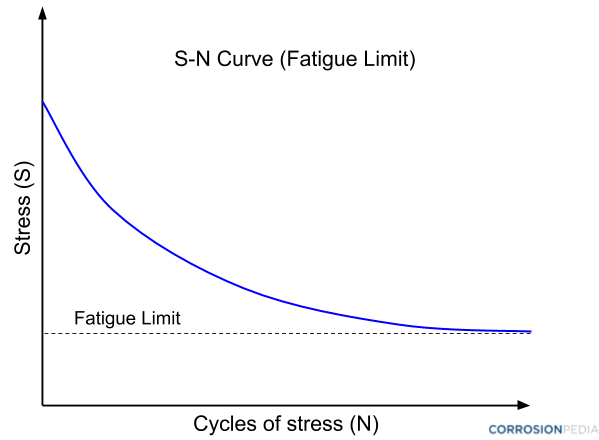What Does
Endurance Limit (Se) Mean?
The endurance limit (Se) of a material is defined as the stress below which a material can endure an infinite number of repeated load cycles without exhibiting failure. In other words, when a material is subjected to a stress that is lower than its endurance limit, it should theoretically be able to withstand an indefinite amount of load cycles.
For example, bolts that are used to hold down machinery are often vulnerable to fatigue. As the machinery vibrates, the bolts experience repeated back and forth load cycles. Eventually this loading can lead to fatigue in the bolt, where the material eventually weakens and the bolt fractures. This action is very similar to bending a paper clip back and forth until it breaks.
However, if the bolt experiences a cyclic loading that is below its endurance limit, it can be expected to endure an infinite amount of vibration without developing cracks or experiencing fatigue failure.
Not all materials have an endurance limit. For example, rigid, elastic, low damping materials, like some thermoplastics or thermosetting plastics, have a very low or non-existent endurance limit.
Endurance limit should not be confused with fatigue strength. The former is a stress limit for infinite load cycles, while the latter describes the maximum stress for a specific number of load cycles.
Endurance limit may also be known as fatigue limit.
Corrosionpedia Explains Endurance Limit (Se)
To better understand the endurance limit, it is first worthwhile to understand fatigue in metals.
Material Fatigue
Fatigue occurs when a metal is subjected to repetitive loading. This load is usually substantially below the yield stress of the material. However, the cyclic action serves to weaken the material, causing it to eventually fail.
Fatigue occurs because most known materials contain defects, in one form or another, at the microscopic level. The defects act as stress risers, causing stress concentrations to develop at local regions. These amplified stresses cause microscopic cracks to form and propagate, eventually leading to fracture.
However, if the stresses applied to the material are low enough, then the material will not experience fatigue under repeated cyclic loading.

Figure 1. Graph of stress versus number of stress cycles, which illustrates the concept of endurance limit. At the fatigue/endurance limit, the material can undergo infinite stress cycles.
How Endurance Limit is Measured
The endurance limit of steel and other materials can be measured using several different testing methods. All tests, however, apply the same basic principle.
First, the test sample is loaded onto the testing device that applies a repeated and predetermined alternating stress to the sample until failure. The applied loading is gradually reduced until the sample undergoes a large number of load cycles (usually around 107 to 108) without showing signs of fatigue failure.
The testing methods used to determine endurance limits depend on the type of fatigue being investigated. Some of the most common testing methods include:
- Axial (Direct-Stress) Test – This test involves applying an alternating axial load (tension and compression) perpendicular to the cross-section of the material.
- Bending Fatigue Test – Bending fatigue testing, as its name implies, involves applying a bending stress on the specimen and measuring its fatigue/endurance limit. The two most common types of bending fatigue testing machines are cantilever beam machines and rotating beam machines.
- Torsional Fatigue Test – This fatigue test applies an alternating clockwise and anti-clockwise torsional stress on the sample. Similar to the other tests, the rotational load is gradually reduced until the specimen is able to withstand a large number of alternating load cycles without failure.